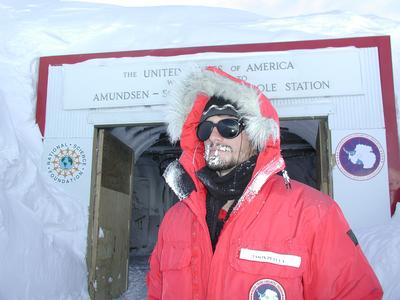25 November, 2001
There are typically science talks every Sunday evening. Science talks are informal presentations in which the researchers can share what they are working on at the South Pole. From what I understand, the talks are well attended. Tonight's talk was cancelled due to the holiday weekend.
The quote of the day, taken from the United States Antarctic Program Intranet states, "Go to Heaven for the climate, Hell for the company." I doubt Mark Twain was thinking about the South Pole when he coined that parcticular phrase, but it does describe one aspect of life down here.
Living on the Antarctic continent has many challenges, so the people rely upon each other in many different ways. Of course survival and safety is most important, but humans are social animals. We need interactions with others, which is why solitary confinement is used as a severe punishment in many prisons around the world.
Each person in Antarctica has a unique story of how they got to the ice. Some people have made a career working in Antarctica, spending numerous year-long stints at one of three permenant stations. A common trend I have seen is people working here for the summer (October-March) and then returning to the United States to work for the National Park Service (May-September). I heard one of the carpenters mention that he only does this so he can see the world.
The carpenter me told how to locate an interesting site just outside the station's perimeter. Many years ago, a LC-130 Hercules plane crashed landed on the ice runway. There were no fatilities, but the plane was obstructing the only means in and out of the station. It was decided to push the wreckage out to the end of the runway. It can still be found there, however it is a challenge to locate. Each year, the winds blowing across the plataeu carry snow which quickly covers anything in its path. The only portion of the plane remaining visible is the upper tail section. In a year or two, the plane will no longer be visible. Since activities are limited, people who locate the plane, tend to contribute to digging a tunnel to its entrance. Currently the tunnel is about 20 feet below the surface. It is anticipated that it will be possible to enter the plane within three weeks.
Because the science talk was cancelled, Mats and I walked out to the wreckage. The walk took a long time, due to the layers of clothing and the bunny boots, which weigh over five pounds each. Nonetheless, the exercise felt good and we got to enjoy a few hours away from the hustle and bustle of the station. It was errie to sit at the crash site, for when the wind died down, not a single sound could be heard. That silence was a harsh reminder of just how isolated we were. With that in mind, we headed back to the dome...for the company
Biological Data
Saturated Oxygen: 88 %
Pulse Rate: 99
Weather Data
Temperature: -35.5 F
Windchill: -41.3 F

The tail from the wreckage of a LC-130 Hercules plane.

Pieces of wreckage found in the tunnel.

Entering the dome after spending some time outside.
Contact the TEA in the field at
.
If you cannot connect through your browser, copy the
TEA's e-mail address in the "To:" line of
your favorite e-mail package.
|
